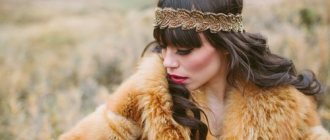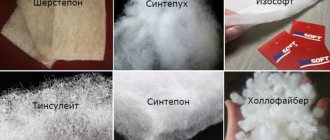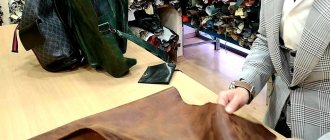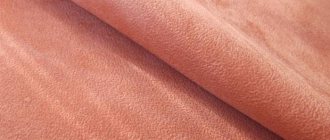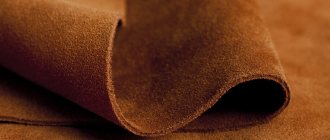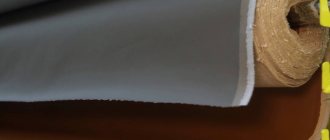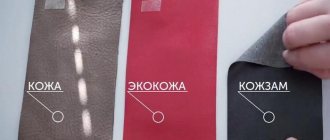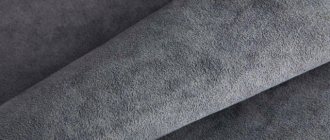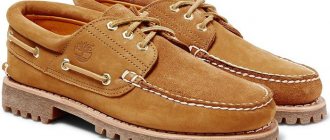What kind of material
Let's start with the fact that artificial suede can be either a woven textile material or a non-woven one, but regardless of the production method, it has a spectacular, stylish look. It is often used for furniture upholstery, giving the products an elegant and expensive look.
Consumers often wonder what is better - flock or artificial suede, which are similar in appearance. In fact, it's a matter of taste. Plus, a lot depends on what you need this or that material for. For example, both are equally suitable for upholstering furniture, but for sewing clothes, the second option is still preferable.
Well, in order to better know the properties of the matter being described, we suggest that you familiarize yourself with its history.
A little historical background
So, artificial suede is a textile that appeared as a cheaper, but no less beautiful alternative to its natural “relative”. It belongs to the new generation of canvases and is not at all cheap, although it is produced at much lower economic costs.
Ecosuede, as artificial suede is also called, appeared quite recently. Even in the last century, people knew nothing about such matters. There were, of course, similar ones, but they did not exist so beautiful, practical and completely imitating the natural texture. Only thanks to modern technologies and new unique impregnated raw materials was it possible to achieve such stunning similarity to the prototype. Moreover, the appearance is so identical to its natural counterpart that an untrained person is unlikely to be able to distinguish between artificial and natural suede.
But still, there are significant differences.
How to distinguish natural material from man-made
If you don’t know how to distinguish natural suede from artificial one, we will tell you now. This is especially important when choosing, for example, shoes or items of clothing. After all, the disappointment of purchasing a product that is not made of the material you wanted will spoil the impression of a new purchase.
The first tip is to carefully consider the textile structure and texture. Of course, for both canvases it will look like skin, but! If the natural analogue is quite heterogeneous, with natural tiny scratches, then ecosuede is smooth, uniform over the entire surface. In addition, natural textiles have a porous structure, and the color may vary in tones in different areas. Artificial ones do not have such signs. Run your palm lightly over the surface of the canvas. If they are natural, then this area will definitely become lighter.
Markings on leather products
Another distinctive feature is the smell. The matter, created by nature itself, has a well-recognized “leather” aroma. Ecosuede smells like synthetics.
The third sign is cost. Artificial textiles are much more affordable.
Compound
The composition of the unique artificial suede fabric is a cotton base plus synthetic polyester fibers. The cotton layer is additionally impregnated with a special composition, the main component of which is Teflon. Thanks to this processing, the material is as durable as possible and can withstand various mechanical impacts without loss of appearance. Such products are durable and easy to care for, which is what arouses great love among numerous consumers around the world.
Today, the production of eco-suede involves two technologies for producing the fabrics in question: woven and non-woven.
Woven method
Microfiber is used for production. Its threads are separated, due to which a characteristic fine pile is formed on one side of the future fabric. The fleecy surface is processed and then combined with a prepared cotton base, creating a uniform, dense and wear-resistant fabric.
This material is considered high quality, practical and elegant. Its elasticity is increased by another treatment with a special compound. The materials are used to sew stylish outerwear: jackets, raincoats, parkas, etc.
Non-woven method
The fibers of this material are formed by polyester fibers, which, as in the first method, are applied to an appropriate base - cotton, silk or synthetic, and, as a rule, knitted rather than woven. It is believed that materials obtained in this way are cheaper and coarser than fabrics. They are used as furniture upholstery or shoe textiles because they require virtually no complex care.
Regardless of the specifics of the production technology, both options are either glued with PVA or laminated, connecting both components into a single whole.
conclusions
Having analyzed various aspects of the manufacture and use of fabrics, as well as a list of characteristics, we can answer the question: what is the difference between velor and suede?
- The basic difference is velvet velor on one side, and suede on both.
- Velor is shiny, suede is more matte.
- Velor is made from wool, the fibers are knitted or woven. The result is fabrics with a smooth backside and a fleecy, velvety front side made of small fibers.
- Suede is made from polyester or cotton with a satin weave or a base and prepared pile are combined.
- Velor and suede are similar in appearance, but differ in composition and manufacturing method.
- Both materials look very decent and have a number of significant advantages.
- It is more difficult to care for velor because this material absorbs dirt and collects dust more easily.
- Most often, upholstery for upholstered furniture and shoes are made from velor and suede.
- Bags are often made from suede.
- Velor is popular as soft home textiles.
- A variety of wardrobe items and outerwear are equally sewn from these materials.
Velor and suede are luxurious, soft, aesthetic fabrics that are used to create elegant clothing, elegant accessories, exquisite upholstery for furniture sets and luxurious car interiors.
These fabrics require delicate care, but the effort expended pays off, and the products delight with a presentable appearance, decorating a car showroom, interior, or the owner directly.
Types and their properties
As mentioned above, all ecosuede is divided into woven and non-woven. But there are other varieties that differ in characteristics (regardless of the production method):
- artificial suede with perforation - has small holes in the structure, which significantly improves the breathability of fabrics;
- double-sided artificial suede – distinguished by identical surfaces on the front and back sides, soft, practically does not stretch;
- artificial suede on a knitted base - differs in that the base layer is not fabric, but knitted jersey.
Manufacturers offer maximum variety in colors: from classic black, gray, white canvases to brighter or, conversely, soft, natural ones. Today the following shades are very fashionable, popular and in demand: burgundy, mustard, mint, dark purple.
Suede fabric - what is it and how is it produced?
Artificial suede replicates the appearance of natural leather: microfiber or polyester fibers are glued onto a knitted base. There are two technologies for producing synthetic suede:
- Fabric method. The woven microfiber cloth is split into fibers using a special brushing machine. This material is more durable, has the ability to “breathe” and, accordingly, is more expensive. With this method, the villi can be of different heights and thicknesses, and the direction of the pile can be any.
- Non-woven method. PVA glue is first applied to the primed substrate (natural or synthetic fabric), then polyester pile is sprayed. To protect against water and dirt, they are impregnated with Teflon.
Pile of material under the action of a brush
For your information! The quality of artificial suede for furniture can be checked by touch: the fibers change direction when touched. This is what is called the writing effect.
Advantages
As mentioned above, artificial suede has the main advantage: it is almost identical in appearance to its natural “sister”, and at the same time it costs much less. Let's list the other advantages:
- a huge variety of colors;
- allows air to pass through well, creating wearing comfort;
- warm, provides an excellent microclimate;
- does not accumulate static electricity.
However, despite its elegant appearance and high performance characteristics, artificial suede has a number of disadvantages.
Flaws
A significant disadvantage of ecosuede is its tendency to get dirty. The material really gets dirty easily, especially if it is light. In addition, such furniture upholstery is resistant to the claws of pets. Although it is quite durable, exposure to thin sharp objects will irreparably damage the skin. That is why such furniture is usually covered with a protective cover if there are pets or small children at home.
Canvases quickly deteriorate from high humidity, begin to delaminate and lose their stylish appearance. Grease stains are practically not removed, firmly eating into the surface.
Application area
Most often, artificial suede is used for furniture upholstery. This upholstery gives a chic look to even the simplest model of sofa or chair. True, it requires some care, simple, but correct.
Home textiles made from artificial suede are also popular: napkins, curtains. Curtains made from such fabrics are especially impressive and authentic. We also produce a variety of accessories made from artificial suede: bags, backpacks, cases. Such belts or belts look unusual. This type of suede is often used for car upholstery. It looks impressive and expensive.
Fashionable items are made from artificial suede: skirts, especially pencil-type models, vests, sleeveless vests, trousers, jackets, dresses, cardigans, jackets, even sundresses. It is also used for outerwear. Now sheepskin coats, coats, men's and women's jackets made of colored faux suede are incredibly popular. They are practically no different from models made from a natural analogue.
Shoes made of artificial suede are popular: shoes, shoes, boots. True, they require more careful care.
Suede care
Suede fabric is demanding in terms of care. If you follow the rules of care, the product will retain its presentable appearance for many years:
- It is better to treat shoes and outerwear before wearing (immediately after purchase, for example, in an online retail store) with special sprays. If the product becomes dirty, dry it and then clean it with a special brush. Shiny areas can be removed using steam and a brush. The movements of the brush must be strictly in one direction.
- Dresses and jackets should be washed or soaked at a temperature not exceeding 40°C. Afterwards the product should be blotted with a napkin or towel. Ironing is strictly prohibited.
- It is worth taking care of furniture upholstery regularly; for example, a sofa should be vacuumed once a week with a soft nozzle. Dry cleaning is also preferred. If water gets on the surface, wipe off the drops and wipe with a damp cloth. Stains can be wiped (do not rub!) with a damp sponge and soapy water and allowed to dry, then restore the pile with a brush.
Soaking suede clothing
